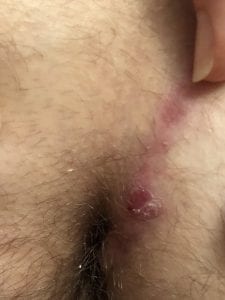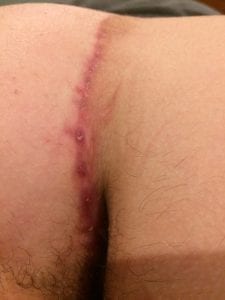- 719 West Hamilton Ave, Eau Claire, Wisconsin 54701
- (715) 832-1044
Suture related problems
- Home
- Suture related problems
When I perform a cleft-lift, there are dozens and dozens of sutures holding the flap in place. Sutures hold tissues in position until the body’s natural healing process takes over and secures them in place. This healing process takes six weeks in a well nourished patient.
In general, we want a suture material that eventually dissolves, so that there is not any permanent foreign material left in the wound. We surgeons have many kinds of dissolving sutures at our disposal, and it has taken me a while to find the suture material that provides the strength needed, but with the least problems. The sutures I use begin losing their strength after about 4-6 weeks, but take as long as 4-6 months to completely dissolve.

I use a synthetic (man-made) monofilament suture (smooth, single-strand, like a fishing line, some are clear, and some are dark greenish-blue). This kind of suture material dissolves over time by the action of enzymes in the tissues. The problem with these sutures is that they lose strength fairly quickly, yet take a long time to be completely removed from the body. Unfortunately, there is no suture material that provides strength for six weeks, and then instantly disappears.
Suture material can cause reactions long after it is done holding things together. These can cause superficial problems manifested by:
- red bumps
- areas of drainage
- areas of bleeding
- thickening of the scar
- small wound separations
In patients with pilonidal disease this can cause a lot of anxiety, as it can easily be confused with recurrence of the pilonidal disease itself. I encourage patients to send me photos of any areas of concern so I can tell them the cause of the visible change. Patients with pre-existing autoimmune diseases (especially those with hiadradenitis suppuritiva) seem to be prone to having reactions to these sutures. Patients who had a contaminated or infected wound are also prone to these problems, some of which are related to bacteria attaching to the suture material and then causing problems later.
These suture-related problems are always self-limiting (if it is in an area away from the midline) – because the suture material eventually dissolves. If there is an area of drainage, it is OK to clean it with peroxide and put a dry dressing on it. If the area is down near the anus, putting a piece of gauze between the cheeks, as you may have done initially post-op, is a good idea until it stops draining.
Below are a few photos of what this can look like. These patients went on to heal without any kind of surgical intervention. Typically, I recommend Vitamin C Serum or Skinuva Scar Treatment (also available on Amzaon) to treat these.
Patient with an irritated suture 4 months after surgery.

Several bumps on the incision from irritated suture material.

